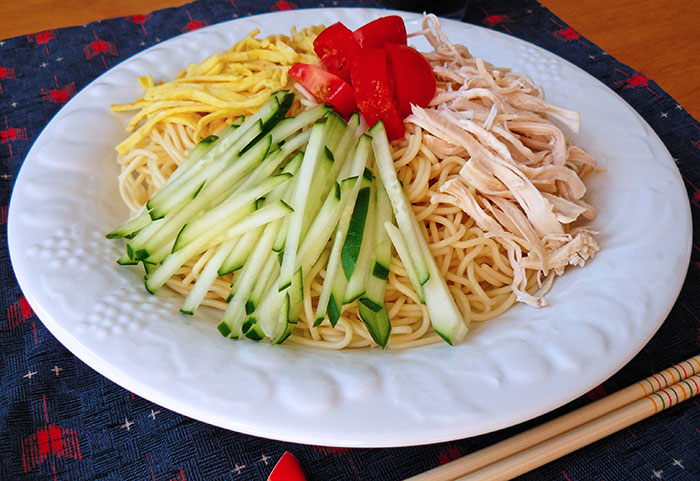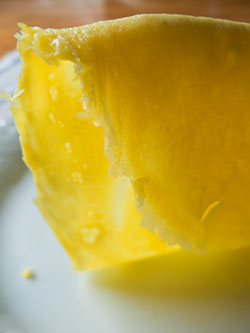
Hiyashi Chûka
| Ingredient | For Two | For Two |
|---|---|---|
| Pasta | ||
| capellini or angel hair pasta | ½ lb. | 200g |
| sesame oil | 1 tsp. | 1 tsp. |
| soy sauce | 1 tsp. | 1 tsp. |
| Vegetables | ||
| cucumber | half | half |
| tomato | half | half |
| Chicken | ||
| chicken breast | ¼ pound | 100g |
| sake | ½ Tbsp. | ½ Tbsp. |
| salt | to taste | to taste |
| water | 3 Tbsp. | 3 Tbsp. |
| shoestring eggs | ||
| egg | 2 | 2 |
| sugar | ½ Tbsp. | ½ Tbsp. |
| sake | 1 Tbsp. | 1 Tbsp. |
| salt | pinch | pinch |
| potato or corn starch | 1 tsp. | 1 tsp. |
| water | 1 tsp. | 1 tsp. |
| sauce | ||
| juice from chicken | 2 Tbsp. | 2 Tbsp. |
| ginger juice | 1 tsp. | 1 tsp. |
| soy sauce | 3 Tbsp. | 3 Tbsp. |
| sugar | 2 tsp. | 2 tsp. |
| rice vinegar | 3 Tbsp. | 3 Tbsp. |
| toasted sesame oil | ½ Tbsp. | ½ Tbsp. |
| Japanese hot mustard | if desired | if desired |
Hiyashi chūka is a light Asian dish a little like a cold pasta salad that is popular in Japan as a cool, refreshing lunch on hot summer days. Equally at home as a slightly exotic lunch or flavorful, healthy dinner alternative to bland low-calorie standbys.
This recipe replaces Chinese noodles with much cheaper and easier to find angel hair pasta, and loses little in the translation. It’s even better if you can find fresh farmer’s market tomatoes to top it with.

Preparation
- Prepare a bowl of ice water with enough water to cover the pasta.
- Prepare ginger juice by grating ginger root and squeezing juice from the grated pulp. It is also possible to buy it bottled.
- Ready a large bowl of ice and water, with enough room to accomodate the cooked pasta without overflowing, just before cooking pasta.
Directions
Prepare each of the ingredients separately; they will be arranged on the noodles when you serve it.
- Prepare chicken.
- Cut the chicken breast in half. Put in microwave-safe plate, the pour the sake and water on, then sprinkle with salt. Cover with plastic wrap or lid and microwave on high until the chicken is cooked through; time will vary depending on your microwave.
- Let cool covered. Reserve the liquid, and shred the chicken by hand into thin strips.
- Prepare vegetables.
- Cut the cucumber into 4cm (2") chunks, then slice the chunks lengthwise into thin strips.
- Cut the tomato in half, then slice into thin wedges.
-
Prepare egg strips.
- Scramble eggs lightly in a bowl, then add seasonings and mix.
- Dissolve the corn starch in the water, then add to the eggs.
- Heat a frying pan to medium-high, then grease with oil and pour a thin layer of egg mixture.
- When the bottom of the egg has become firm, loosen the edges and flip it over; try to keep it from tearing. Put the omelette on a plate once it’s cooked through. Repeat until you’ve cooked all the egg mixture.
- Cut the omelets into 4cm (2") strips; stack a few of the strips and cut the other direction into small, thin strips.
- Prepare sauce.
- In a bowl combine the soy sauce, vinegar, and sugar; stir until completely mixed.
- Add sesame oil, the reserved chicken liquid, and ginger juice and mix well.
- Prepare pasta.
- Cook the pasta according to the directions on the package, until cooked all the way through, with no stiff part left in the center of the pasta–do not cook it al dente.
- Drain and immediately transfer the hot posta to the bowl of ice and water and swish around until fully chilled; this will clean off any starch and firm the texture. Thoroughly drain the pasta in a strainer and remove any remaining chunks of ice.
- Put the drained pasta in a bowl, mix sesame oil and soy sauce, then pour over the pasta and toss to coat.
- Plate.
- Put one serving of pasta on each plate.
- Lay the tomato, chicken, cucumber, and egg strips on top in a decorative layer.
- Pour sauce over the top of the pile and serve. Put a dab of mustard on the side of the plate, if you like, and mix as you eat.
Notes
- Though chicken breast is fine, chicken tenderloin is preferred; you can also substitute strips of ham or roast pork. If you’re substituting ham or pork use water in place of the reserved liquid.
- If you pour the egg mixture through a mesh strainer it will more thoroughly mix the yolk and white, making for a prettier omelette.
- Though an American cucumber will work fine, it will taste better if you use an English cucumber, or, if you can find one, a Japanese cucumber or the very similar Persian ("mini") cucumber.
- When cooking the pasta, use about 2 liters (a half gallon) of water and 1 Tbsp. salt per 200g (7 oz.) of dry pasta. While most recipes would have you cook pasta to al dente (slightly undercooked in the center of the noodle), this particular one requires fully-cooked pasta, instead relying on the step of rapidly chilling the pasta in ice water to firm up the texture.
